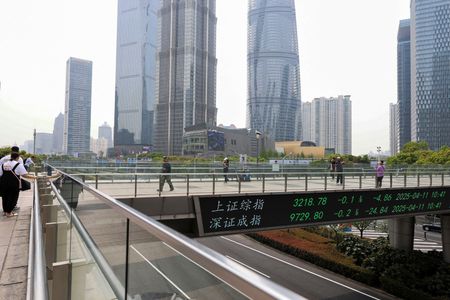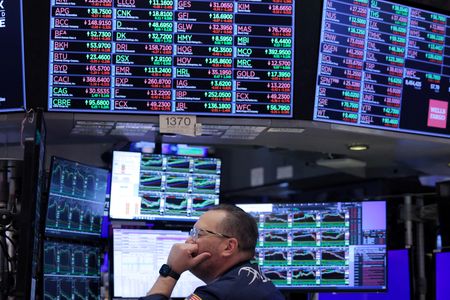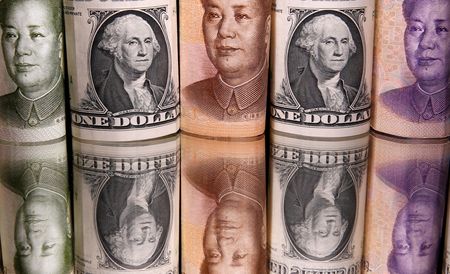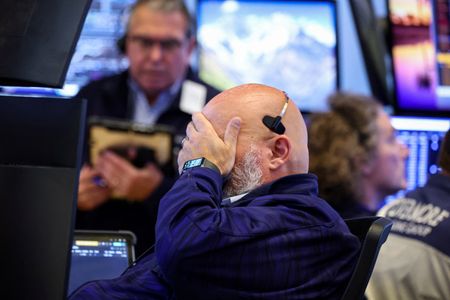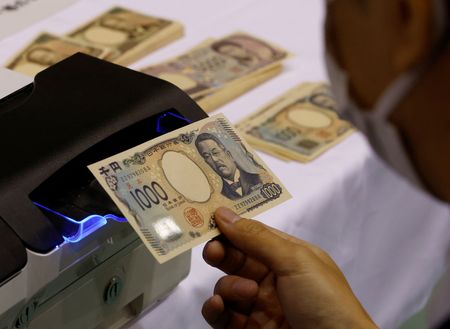By Wayne Cole
SYDNEY (Reuters) -Asian stocks dived for cover on Monday after fresh broadsides in the U.S.-China trade war spooked markets with already stretched valuations, though there were signs risk sentiment had steadied with Wall Street futures bouncing.
A holiday in Japan and the United States made for choppy early trading and political uncertainty still shrouded Japanese and European assets.
While U.S. President Donald Trump had threatened 100% tariffs on China from November 1, he sounded more conciliatory over the weekend, posting that everything would be fine and the U.S. did not want to “hurt” China.
Beijing defended on Sunday its curbs on exports of rare earth elements and equipment as a response to U.S. aggression, but stopped short of imposing new levies on U.S. products.
“We expect the ultimate resolution will be an extension of the current tariff pause past November 10 along with some new but limited concessions from both sides,” wrote Jan Hatzius, chief economist at Goldman Sachs in a note.
“However, the recent policy moves suggest a wider range of outcomes than was the case ahead of prior U.S.-China talks, with the possibility of greater concessions but also a risk of substantial new export restrictions and higher tariffs, at least temporarily.”
Many world leaders, including Trump, are due to meet in Egypt on Monday to discuss ceasefire plans for Gaza.
Japanese markets had their own problems with the ascension of new LDP leader Sanae Takaichi to prime minister now in doubt, contributing to a sharp rebound in the yen and a 5% dive in Nikkei futures on Friday.
The Nikkei was closed on Monday. Futures were trading up 1.5% at 46,770 but that was still far below the cash close of 48,088.
Shares in South Korea slid 1.3%, while Australia lost 0.6%. MSCI’s broadest index of Asia-Pacific shares outside Japan dropped 1.6%.
Chinese blue chips fell 1.3%, though the rare earth and semiconductor sectors both firmed. Data pointed to some resilience in trade with exports rising 8.3%, almost twice the forecast, and imports up strongly.
EARNINGS, FED LOOM LARGE
Wall Street was making a comeback with S&P 500 futures rallying 1.3%, while Nasdaq futures jumped 1.8%.
Earnings season kicks off this week with major banks reporting, including JPMorgan, Goldman Sachs, Wells Fargo and Citigroup.
S&P 500 companies overall are expected to have increased earnings by 8.8% in the third quarter from a year earlier, according to LSEG IBES, and strong results will be needed to justify the market’s high valuations.
Politics also cast a cloud over Europe as the French presidency announced Prime Minister Sebastien Lecornu’s new cabinet line-up on Sunday, reappointing Roland Lescure, a close ally of Emmanuel Macron, as finance minister.
Lecornu’s last cabinet lasted just 14 hours, and he still faces a tough task to steer a budget for 2026 through a deeply divided parliament.
EUROSTOXX 50 futures edged up 0.4%, while DAX futures firmed 0.5% and FTSE futures 0.1%.
Currency markets saw some stabilisation after Friday’s rush into the traditional safe havens of the Japanese yen and Swiss franc. The dollar gained 0.5% to 151.98 yen, having slid 1.2% on Friday from a top of 153.29.
The euro was steady at $1.1617, while the dollar nudged up 0.2% on the Swiss franc to 0.8010. The dollar index was off 0.1% at 98.921, after losing 0.6% on Friday.
In bond markets, cash Treasuries were closed for a holiday but futures slipped 5 ticks as sentiment steadied.
Yields had hit multi-week lows in the wake of Trump’s tariff threat, while investors had added to wagers on more rate cuts from the Federal Reserve.
Futures implied around a 98% chance of a quarter-point cut from the Fed later this month, and a similar probability of another move in December.
Fed Chair Jerome Powell has a chance to offer his guidance when he speaks on the economic outlook at the NABE annual meeting on Tuesday.
A host of other Fed members are appearing this week, along with a who’s who of central bankers attending an IMF-World Bank meeting in Washington.
In commodity markets, gold remained in high demand as a hedge against fiscal and political uncertainty, rising 0.8% to $4,049 an ounce and pipping last week’s record to touch $4,059. [GOL/]
Oil prices also regained some ground on hopes the U.S. and China would find some compromise on trade to avoid fresh tariffs. [O/R]
Brent bounced 1.6% to $63.74 a barrel, while U.S. crude rose 1.6% to $59.88 per barrel.
(Reporting by Wayne Cole; Editing by Sam Holmes and Muralikumar Anantharaman)

